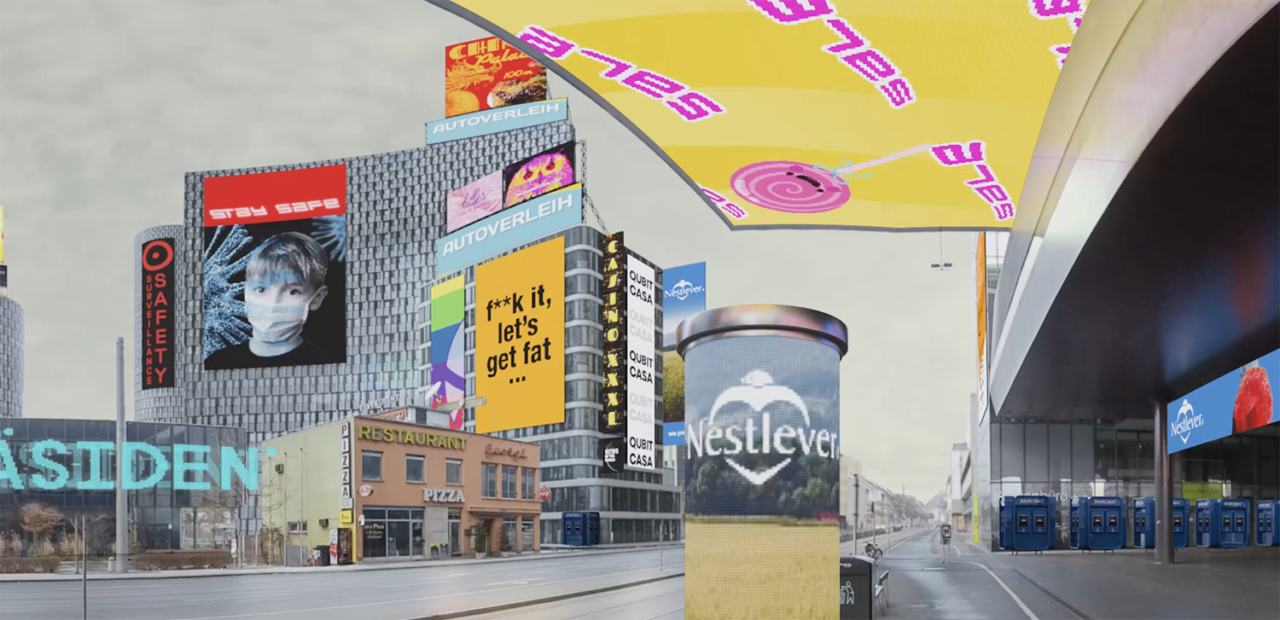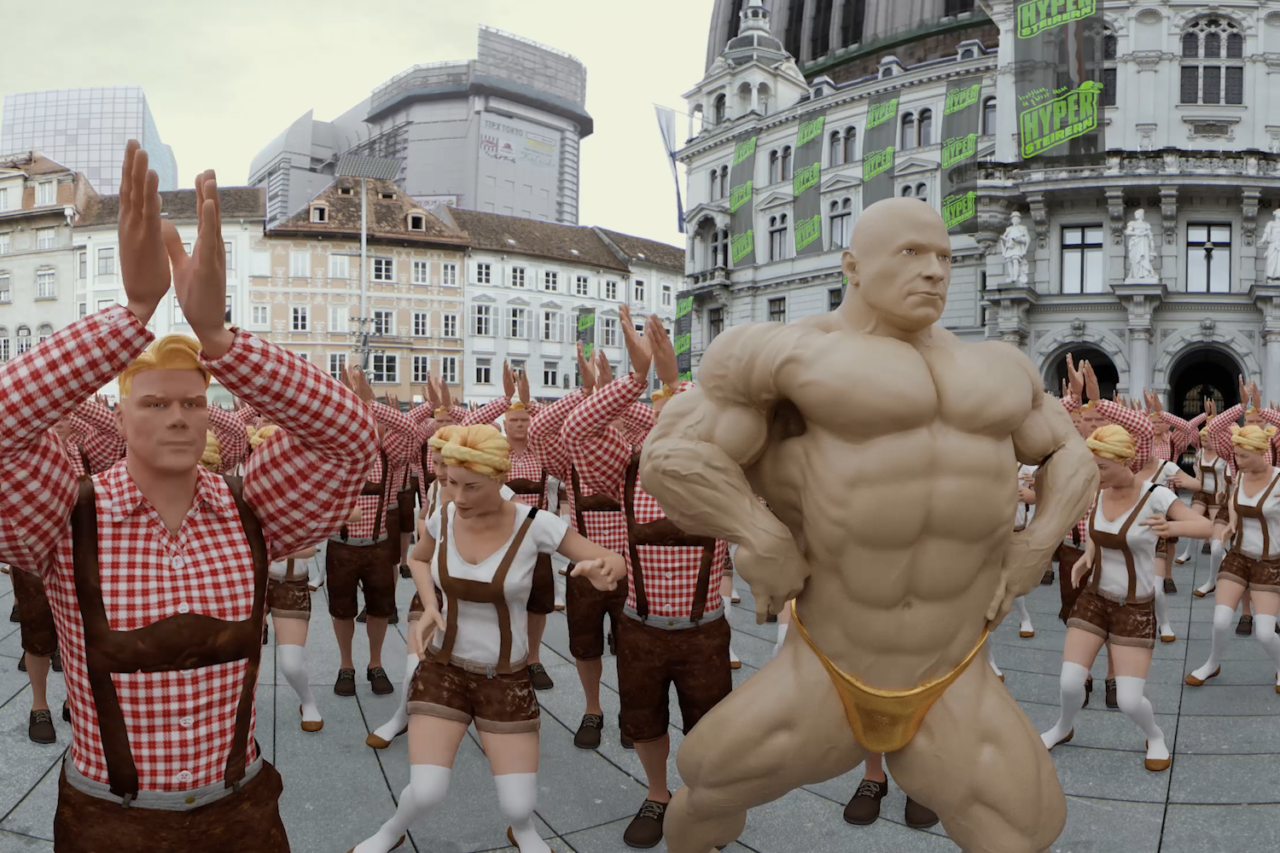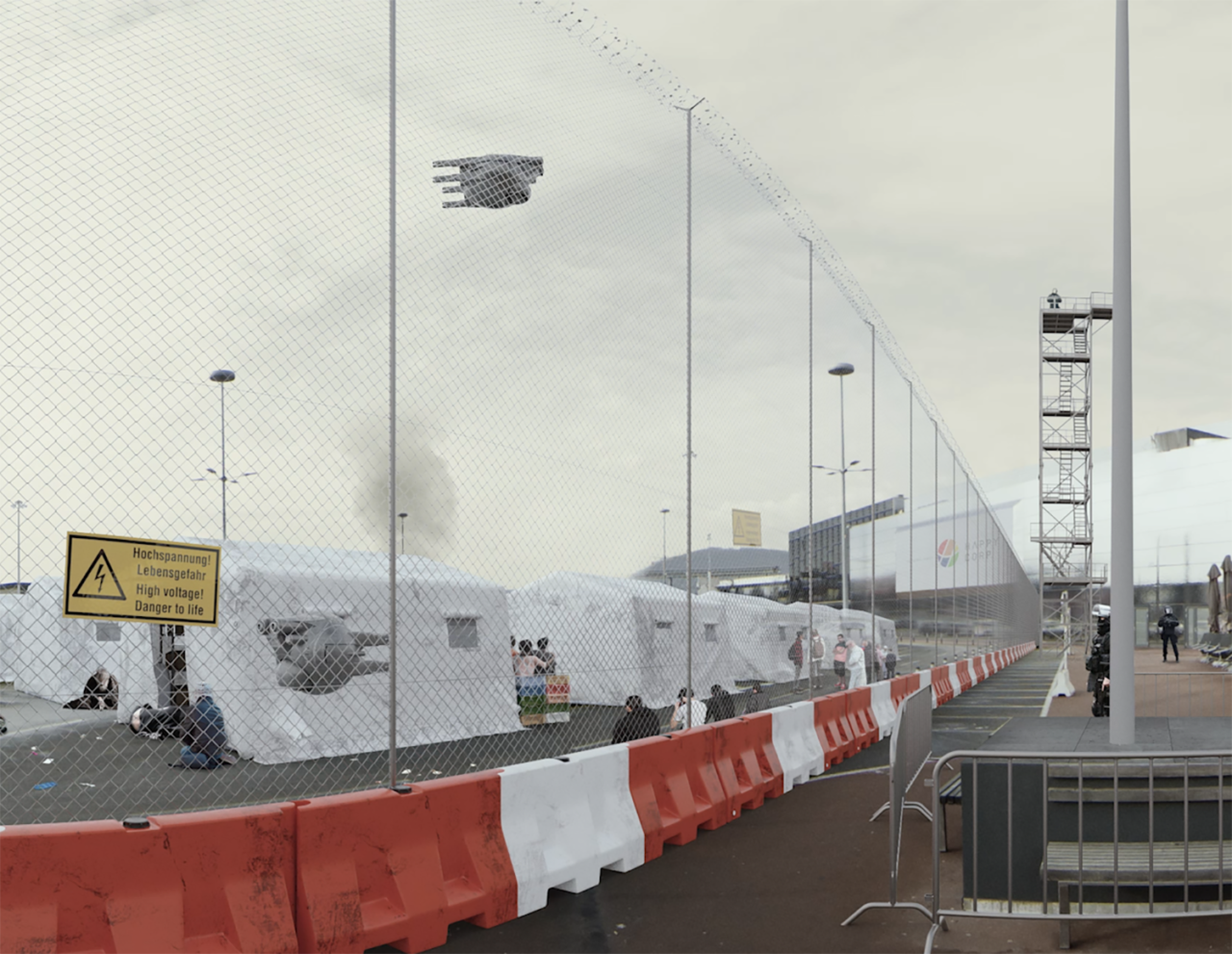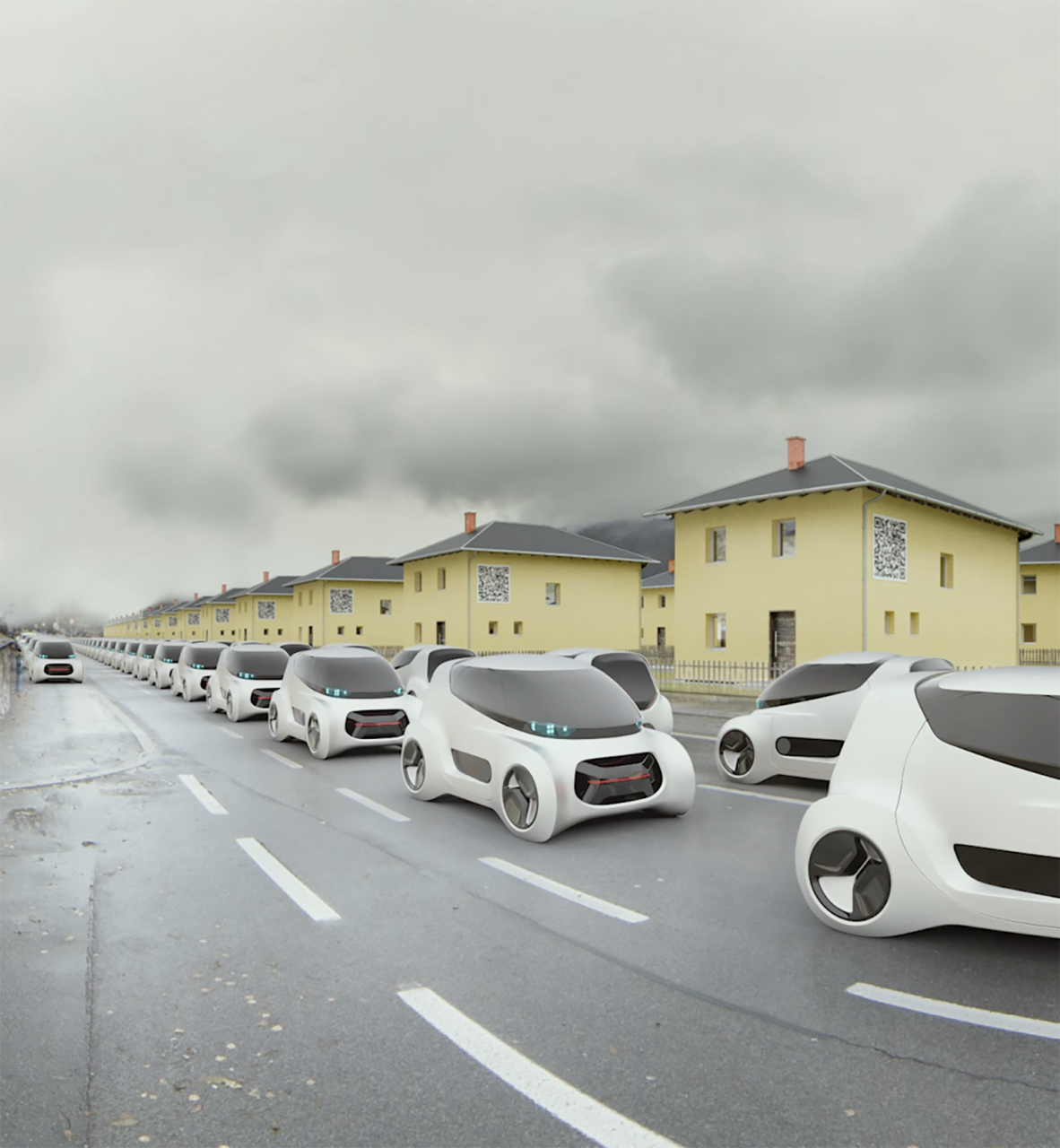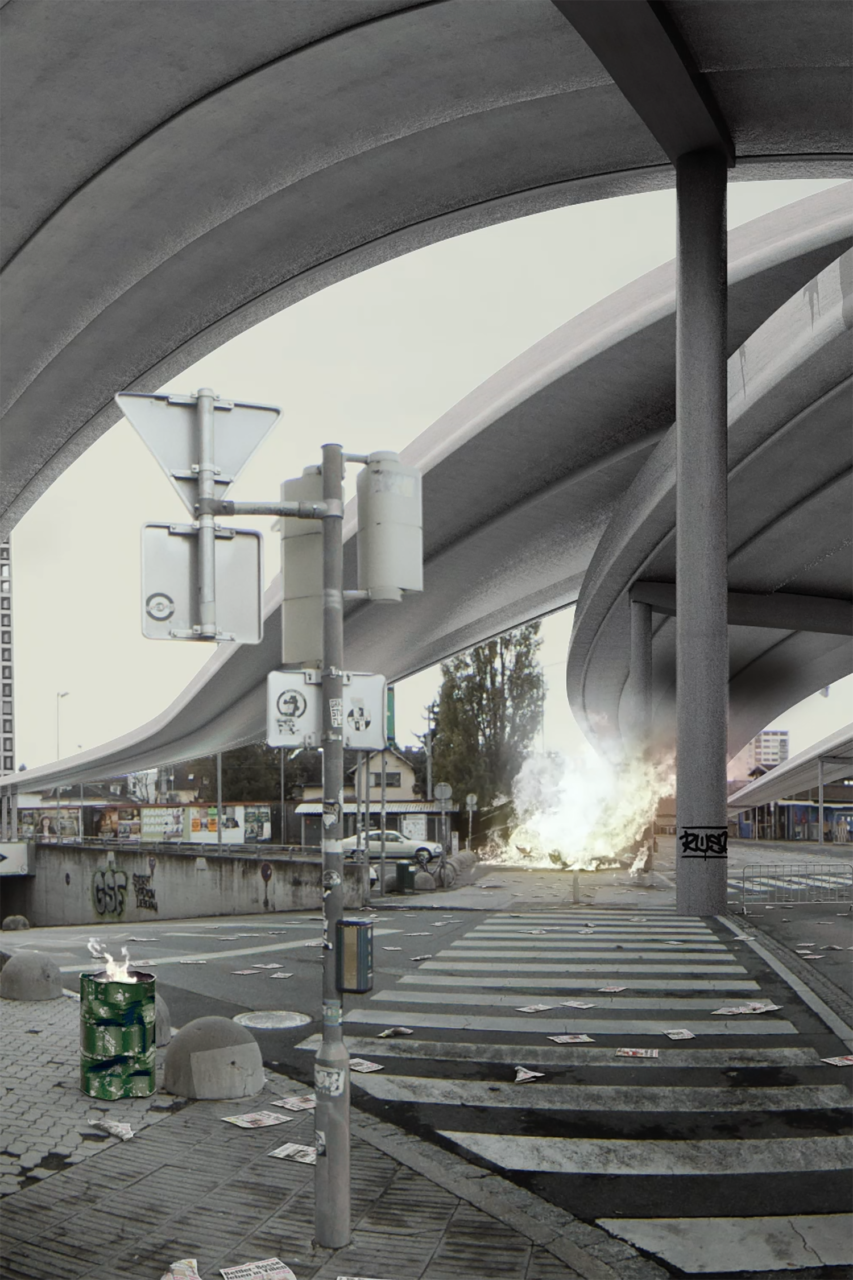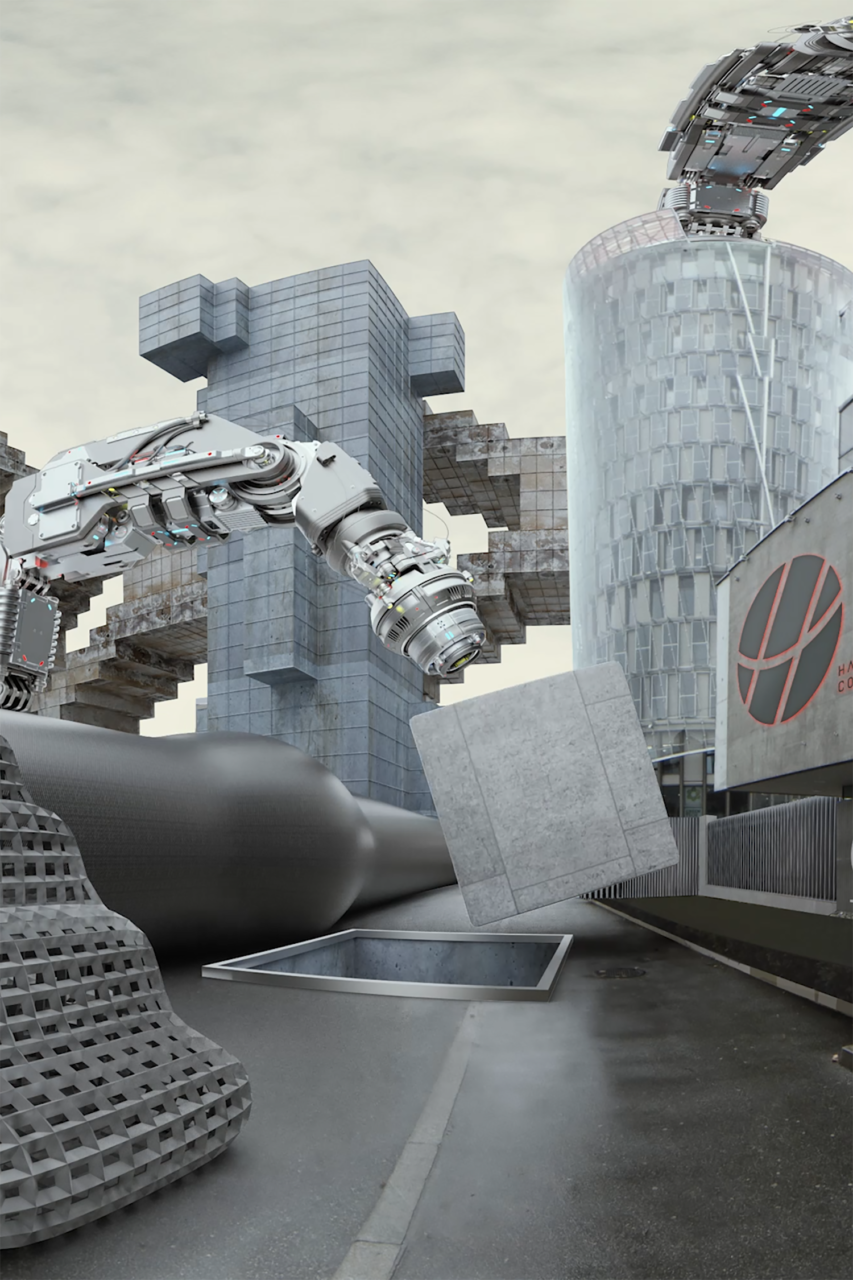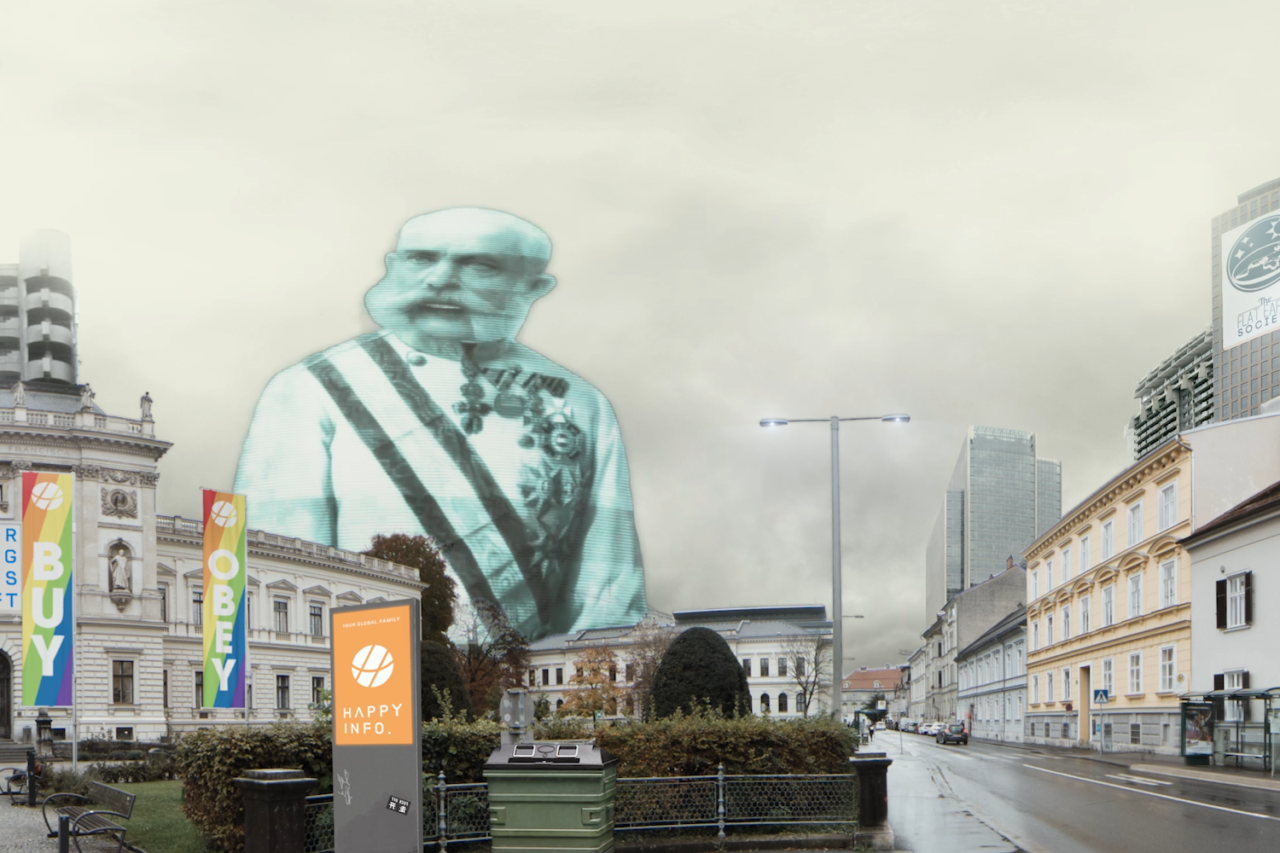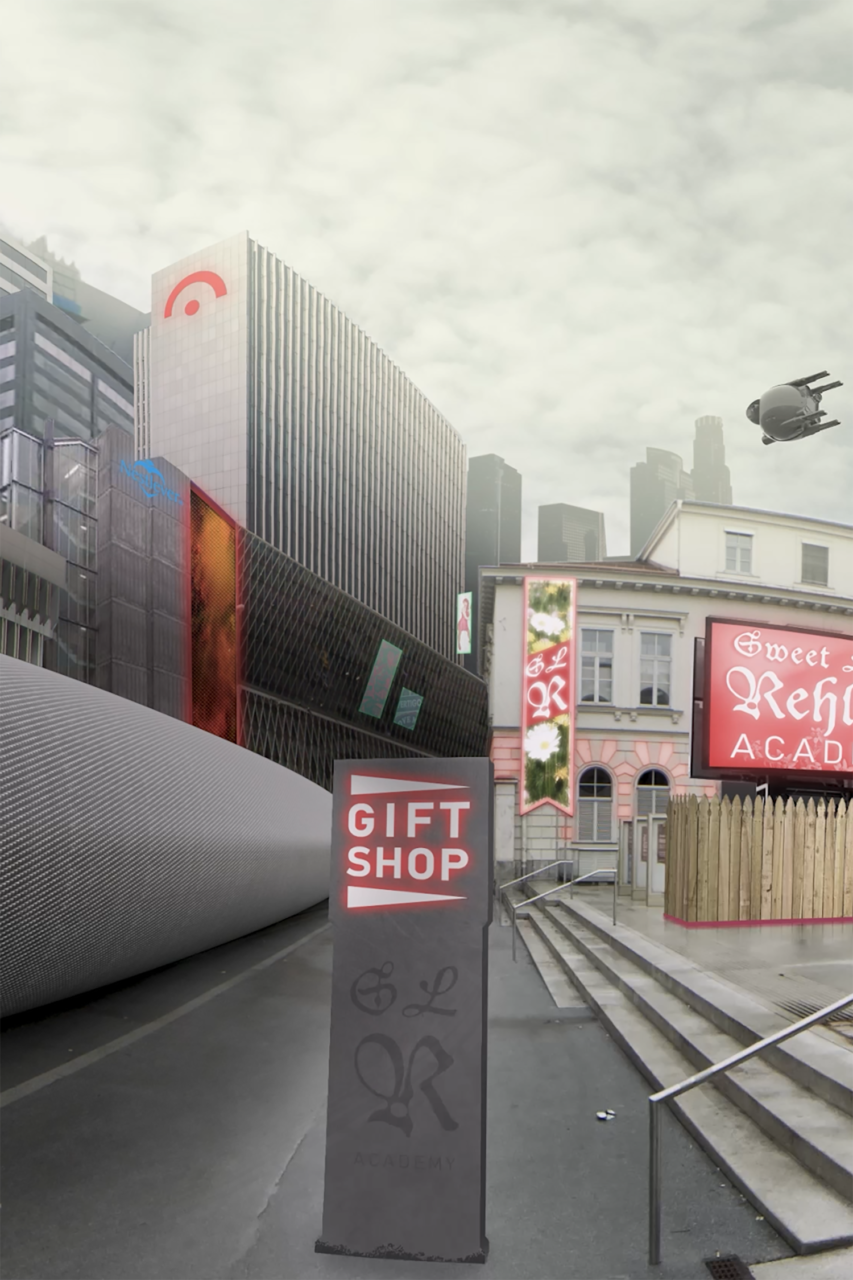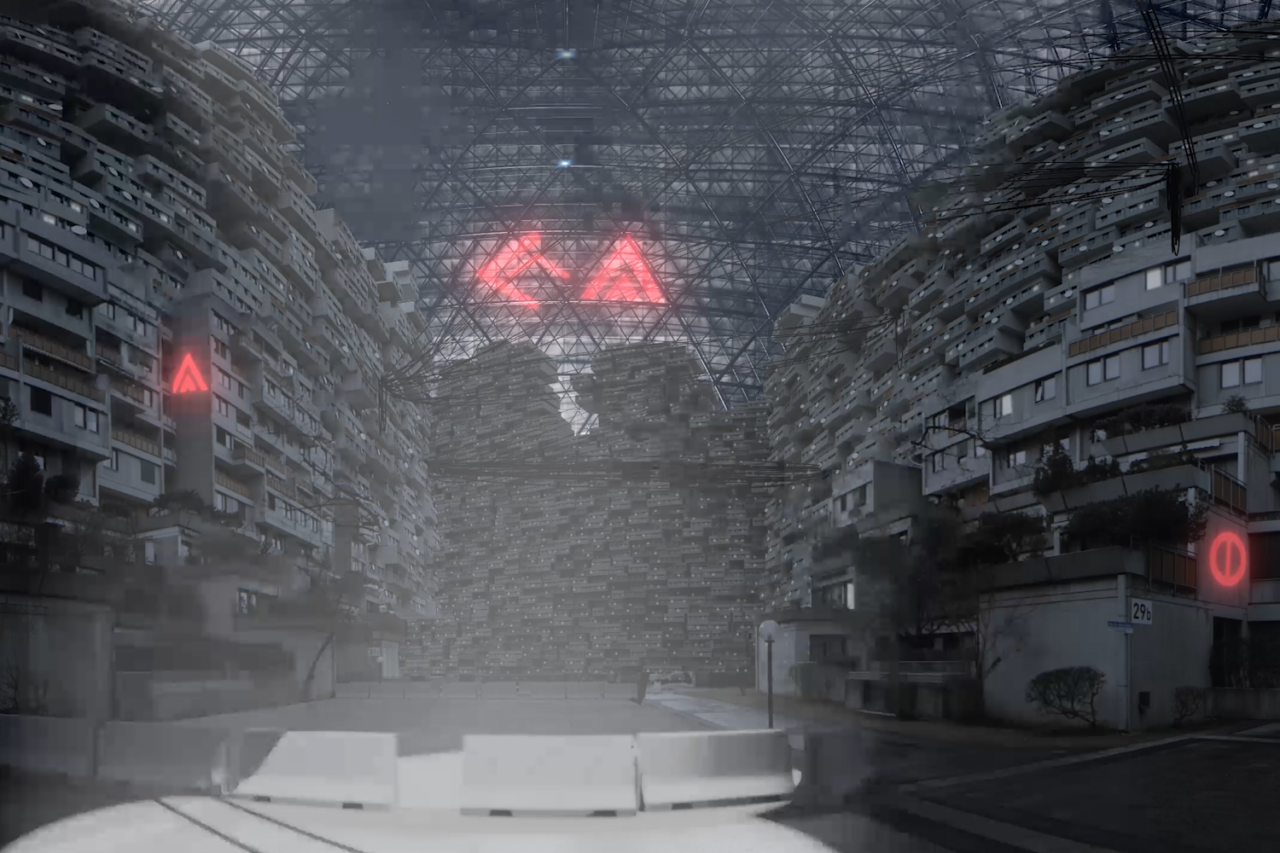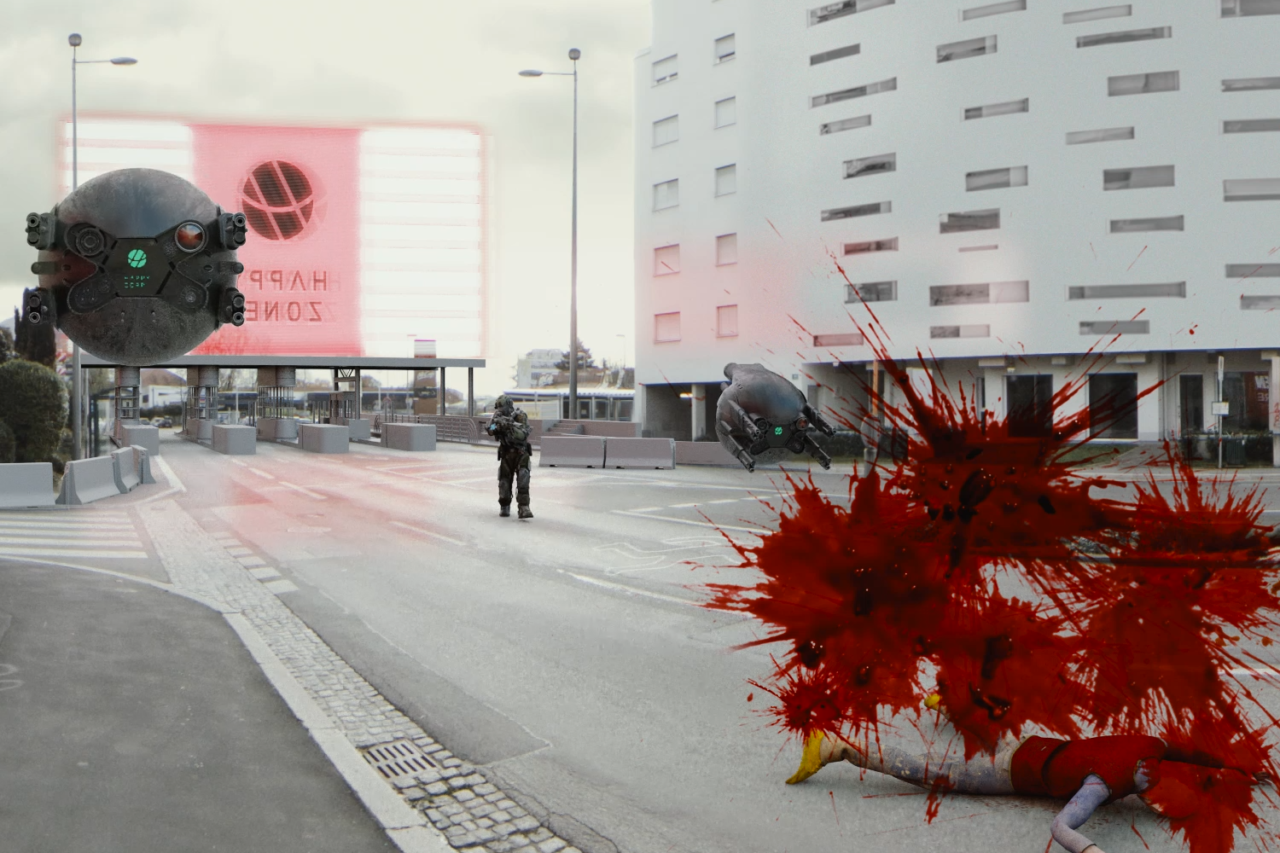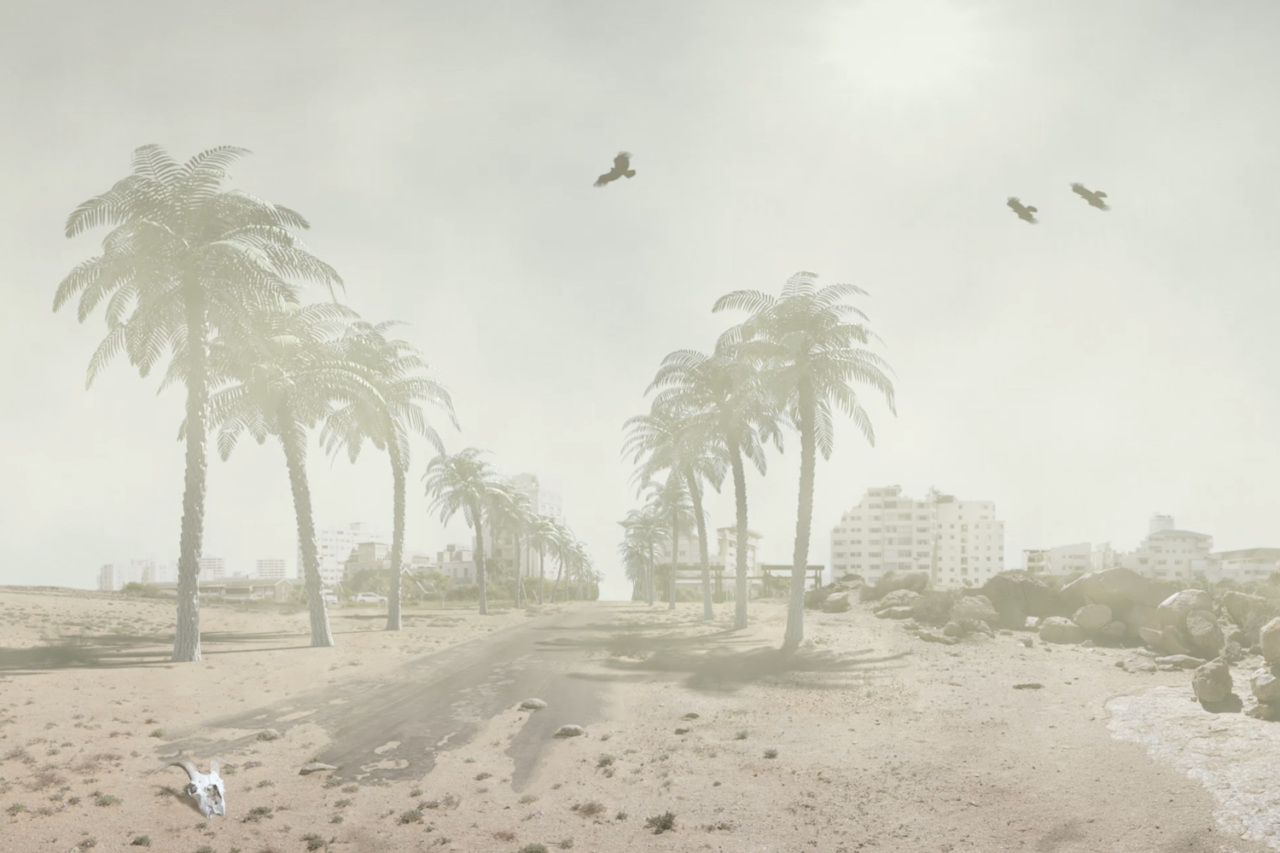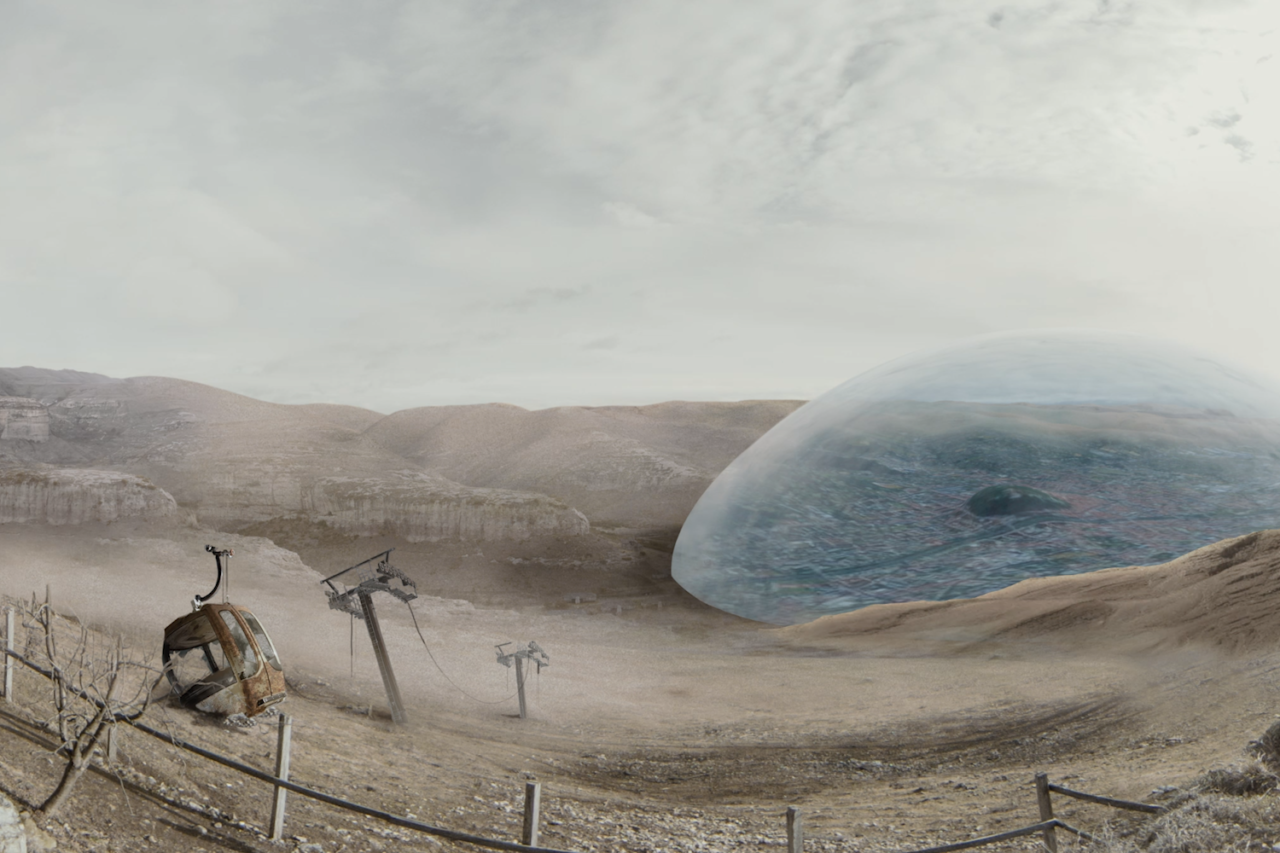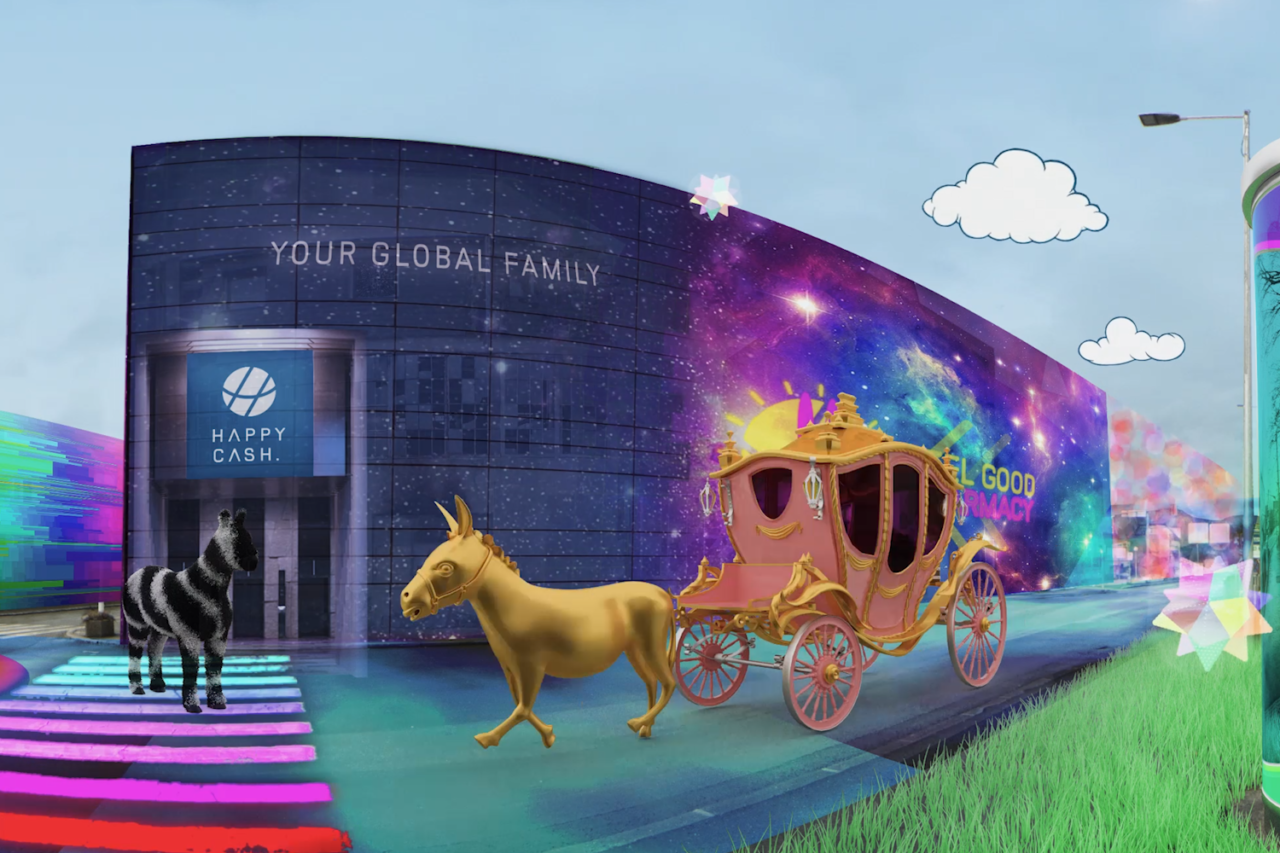Hyperconsumerism
The Year 2029 – The economist Selman Shapiro has been awarded the Nobel Prize for Economy for his era-defining work 'The Limits of Productivity' which helped change the paradigm of 'Production' to the paradigm of 'Hyperconsumerism' and to transcend capitalism to its next manifestation. True to the prerogatives of this school of thought every possible means of increasing consumption needs to be exploited. In the early years of this new stage of capitalism it meant blatantly making uses of every square-inch of public space for advertisements, i.e. 'Consumessages'.


Village People
The Year 2033 - The endemic feeling of being 'at a loss' swept wide parts of the consumers. This, as predicted in 'The Limits of Production', was a natural psychological side effect, a mass-phenomenon if you will, of the early incarnations of Hyperconsumerism. The obvious and most readily available 'medication' for this 'buyer's loss' was to step up the markers and simulacra of a sensation of belonging, to create an ersatz-community, so to speak, by means of reviving pseudo traditions in form and function. In its nucleus this bogus-heritage had been around since before the turn of the century. However, in the first third of the 21st century these 'stagings' of folklore and tradition were being stepped up to unprecedented levels, both in frequency and esthetics. The aim was to create a pseudo-religious enthusiasm, unreflected and visceral ex ovo et origine, which should carry the consumer over periods of 'buyer's loss' and help increase the median of consumption.
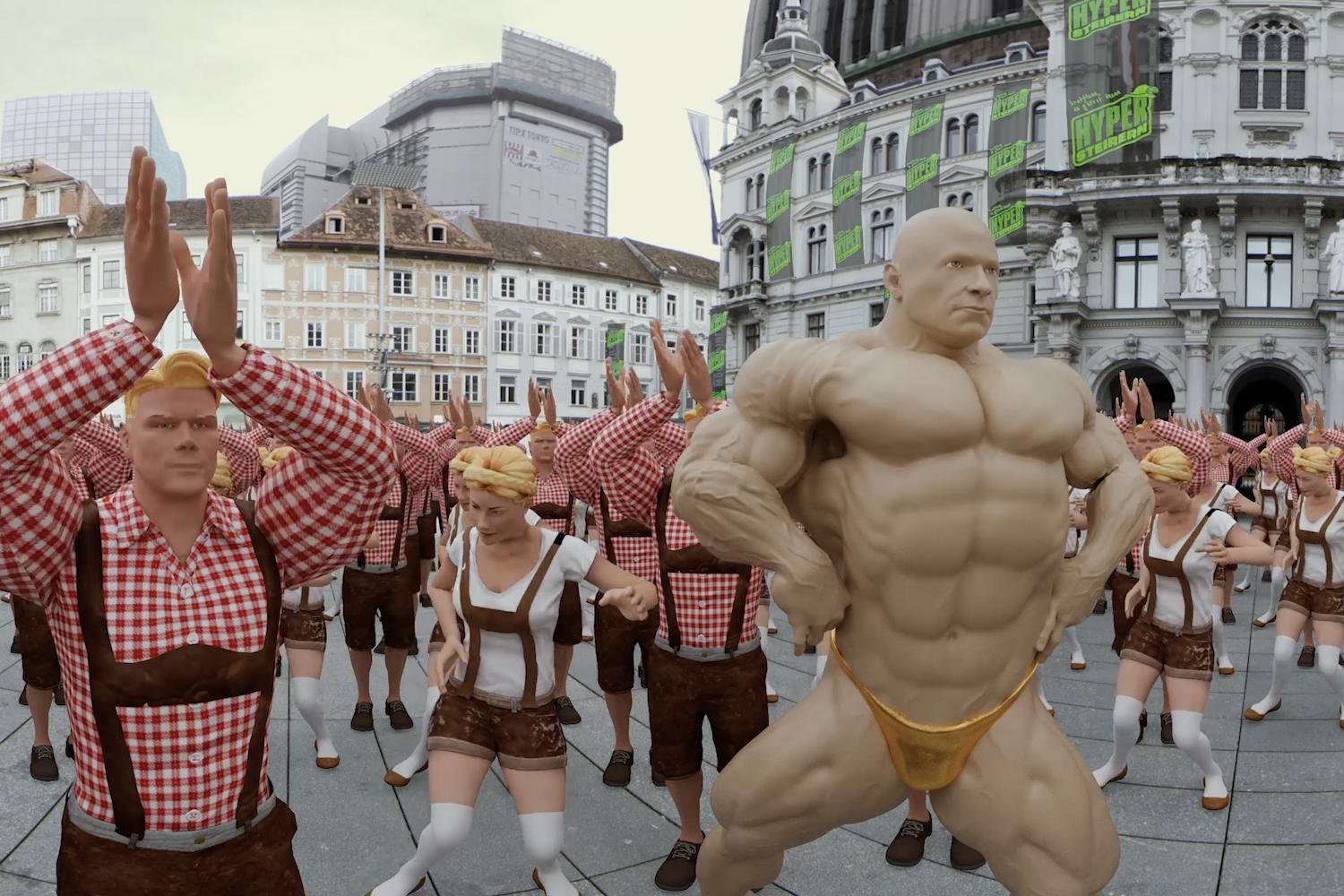
Climate Refugees
The Year 2041 - Seven consecutive years of drought on the Iberian Peninsula and scorching summers caused a mass-migration of low-strata-consumers from Spain and Portugal to the northern countries. The scale and intensity of these Endo-European movements caught the local governments and administrations unawares and therefore totally unprepared. Another factor which aggravated the situation and increased the numbers of refugees was the uninhibited use of AI technology to assess individual economic situation and credit-worthiness as a field test in Greece. This pushed many low-strata-consumers, that had previously been able to enjoy basic social securities, into social free fall. Consecutively, these 'no-credits' moved to countries like France, Germany or Austria, where this technology had not yet taken full effect.
Even though efforts were stepped up to supply the migrants with basic food and shelter, the facilities soon met the limits of their capacities. Make-shift camps were set up in public and semi-public places like parking lots and industrial areas.
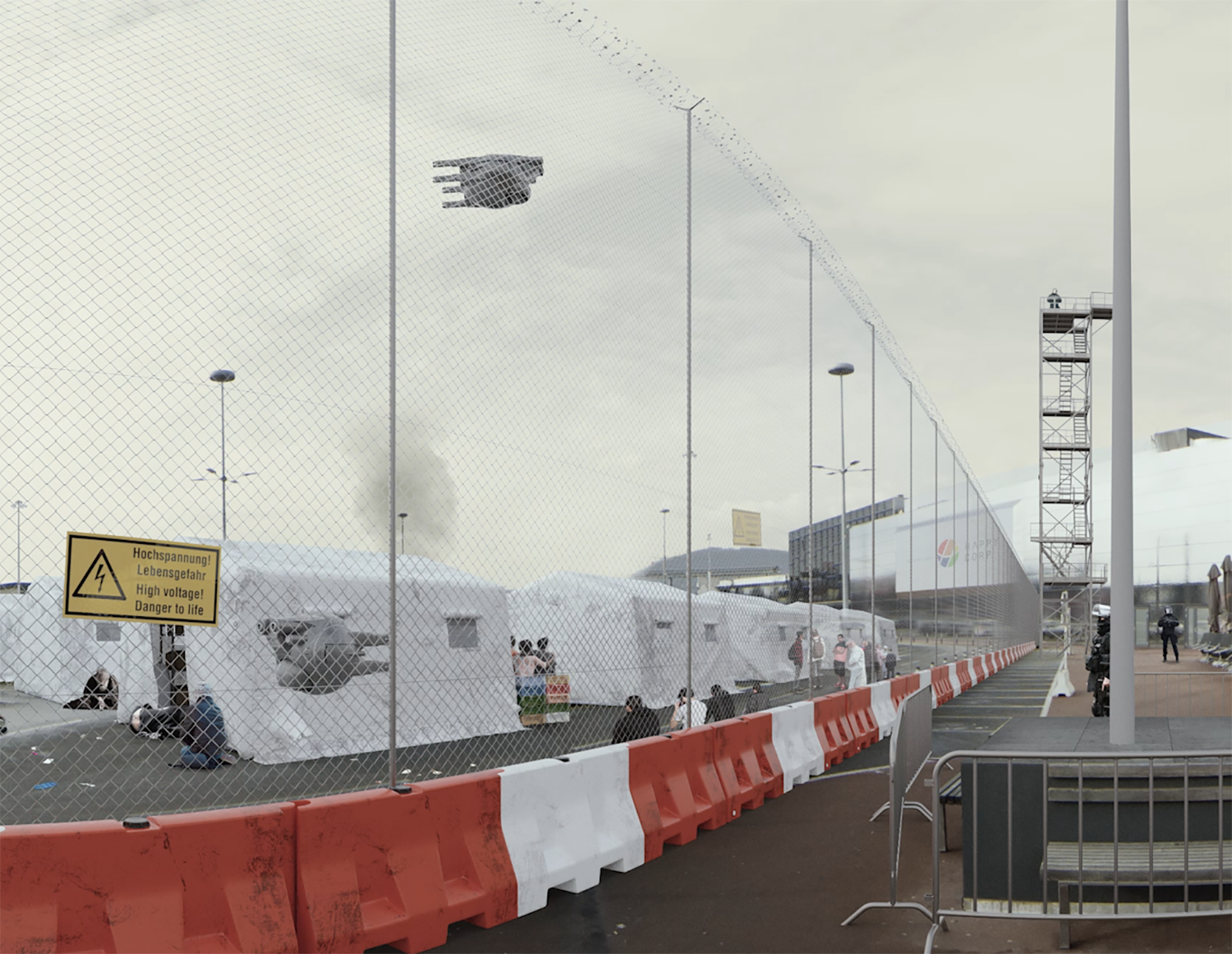
Clone Sweet Clone
The Year 2045 - The need for new, more cost-effective buildings quickly arose due to the widespread use of planned obsolescence in building structures and materials in previous decades. On the other hand the desire for detached housing structures entered new levels as multiple dwelling solutions were seen as a sign of low-strata-consumer status by clients. The 'solution' for combining these opposing parameters was to create identical single family houses in industrial numbers. Clone-houses were built in their tens of thousands, merely distinguishable by their QR-Facade.
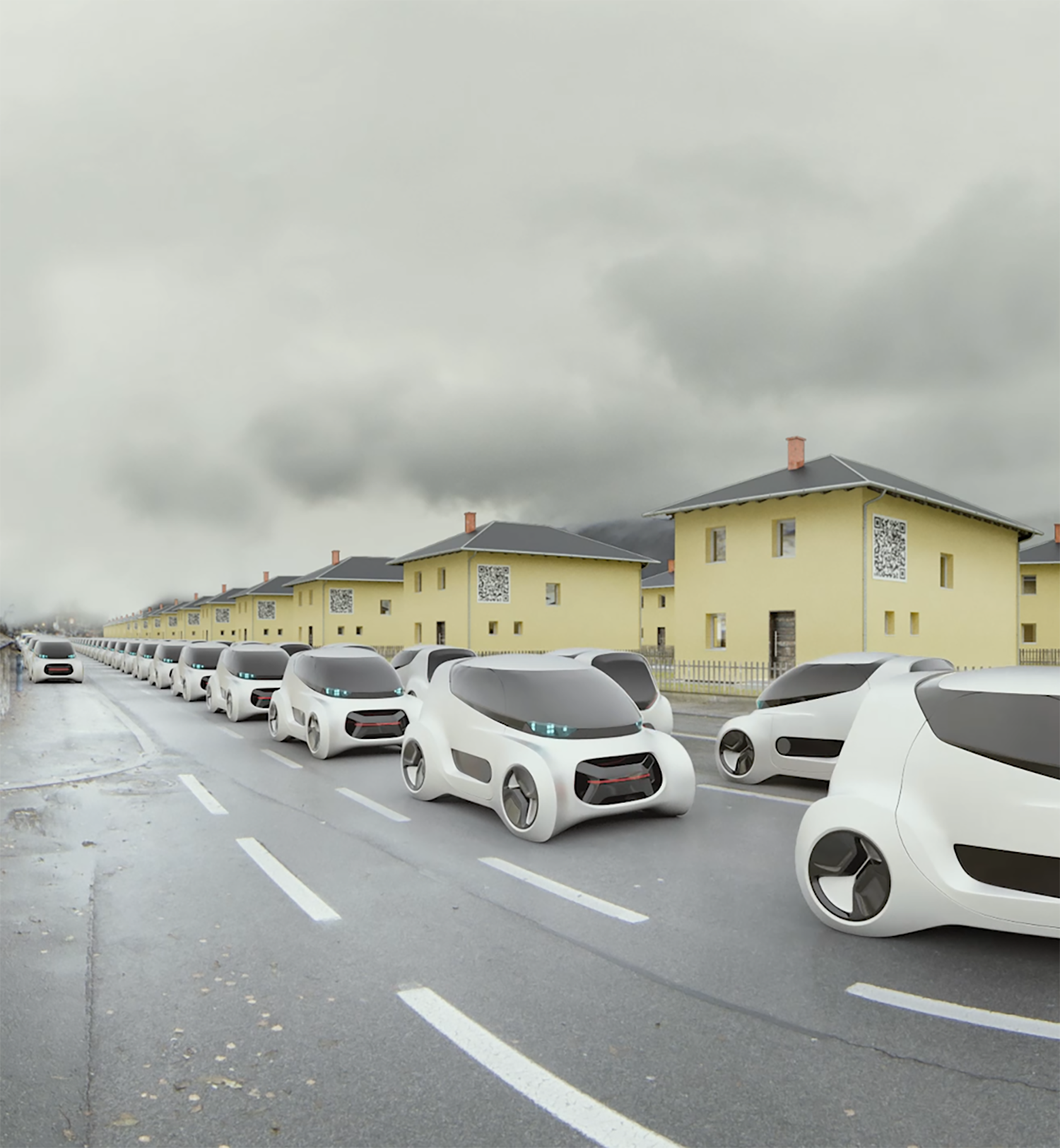
Cluster Truck
The Year 2057 - Unabated increase of private transport made it necessary to build multilevel road structures to cope with the extensive scope of traffic. These structure were more often than not built on top of the city's old main arteries, which, subsequently turned into habitats of low-strata-consumers and expels. Providing ever rarer shelter from the scorching sun to those not able to afford a 'cocoon' (entry level housing structure, about 4,5 m3), the fly-unders, as those individuals were soon to be known, were prone to data-blocker drug use and other petty crime.
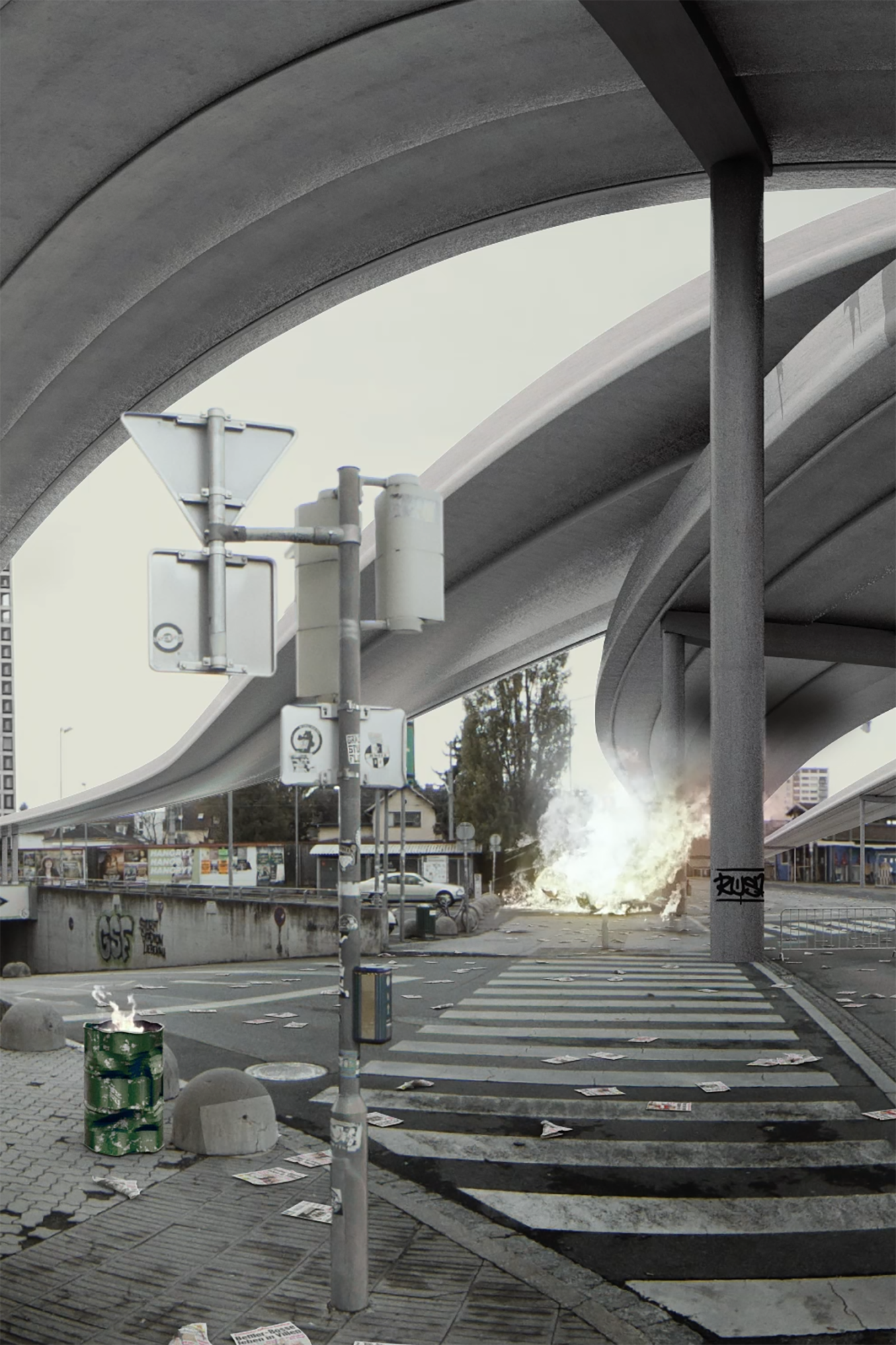
Unboxing Day
The Year 2060 - Due to the increased heat-conservation within urban perimeters and higher median temperatures unforeseen problems arose regarding the durability of EPS insulations, that had been used on a broad scale during the early part of the century. Furthermore technical standards for these styrofoam boards had been lowered in an attempt to facilitate higher production numbers during the late 2020s. These factors led to a rapid deterioration and subsequent dismantling of almost all exterior EPS-insulations. A lack of adequate waste-management created the need for vast landfills within the city's boundaries, as all communities were hit with a similar set of problems.

Build That Wall
The Year 2063 - After long and extensive lobbying by high-strata-consumer groups under the guidance of the Swedish 'Happy Corporation' general legislation was ratified in Eurasia to privatise public spaces. This move, it was argued, had become necessary to protect the interests and safety of the high-strata class due to uncontrollable and ever growing utilisation of space by expels and low-strata-consumers in areas traditionally not suited for them.
This, too, seemed to be a late consequence of the migration crisis of the early 2040s. Swiftly structural changes were being implemented in urban developments and topographies.
The 'Happy Corporation' became the main supplier for privatisation equipment ranging from 'Spikes' (electrically charged steel barriers) to face-recognition surveillance drones, called 'Parrots'.
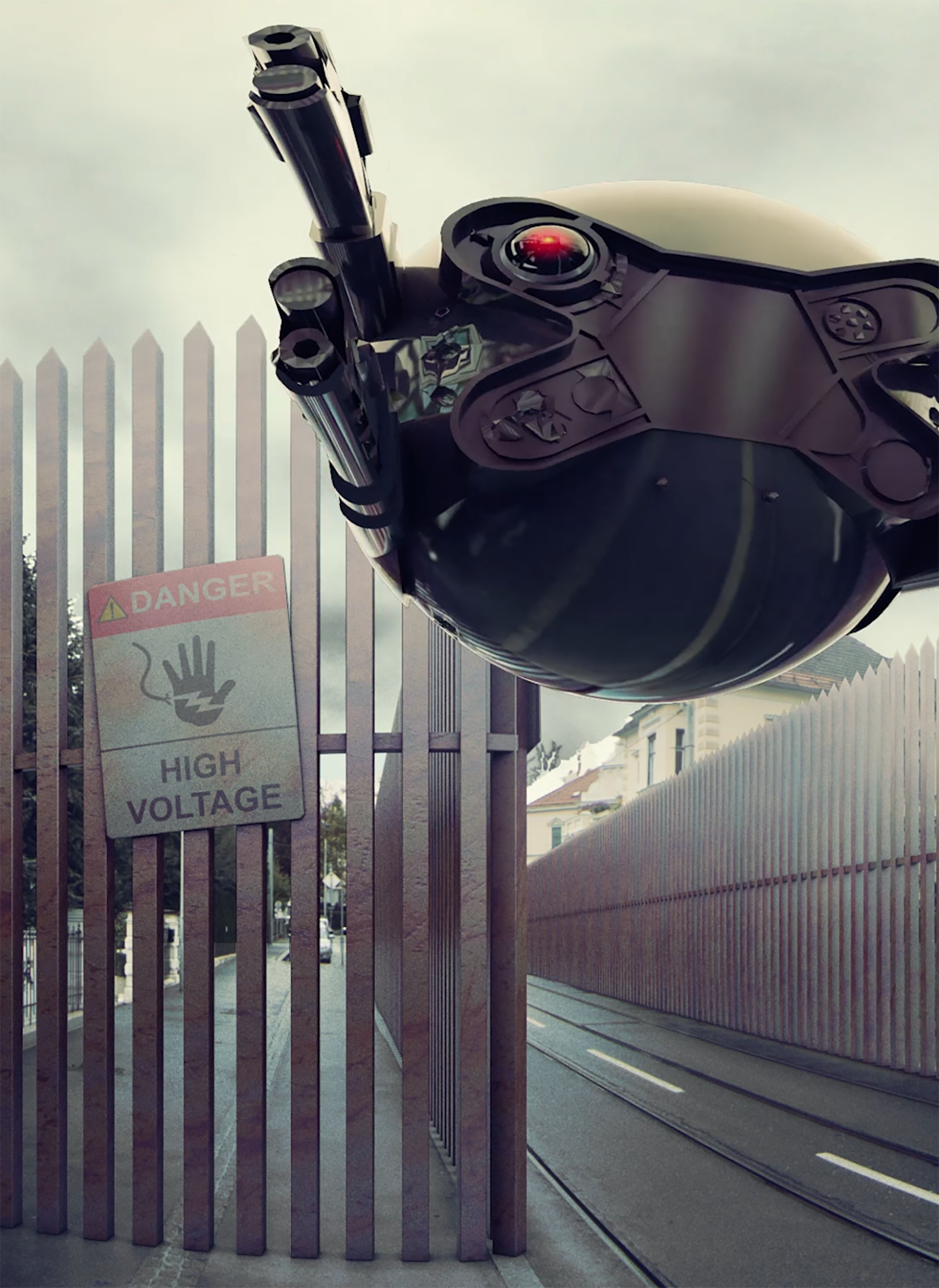
Classified
The Year 2066 - Venturing further into social stratification widespread support was garnered when suggestions were made to manifest human classification even more clearly by implementing social hierarchies in the urban geography. So called 'Happy Zones' were introduced that were subject to a certain socio-economic standing. Without the required amount of the general proxy-currency 'Happy Points' one was barred from entering the 'Happy Zones' which usually lay within the inner urban perimeters.
In these areas the service level was extensively higher, cleanliness and air quality was improved. A minimum consumption was required by visitors which was charged automatically from their 'Happy-Points' account.
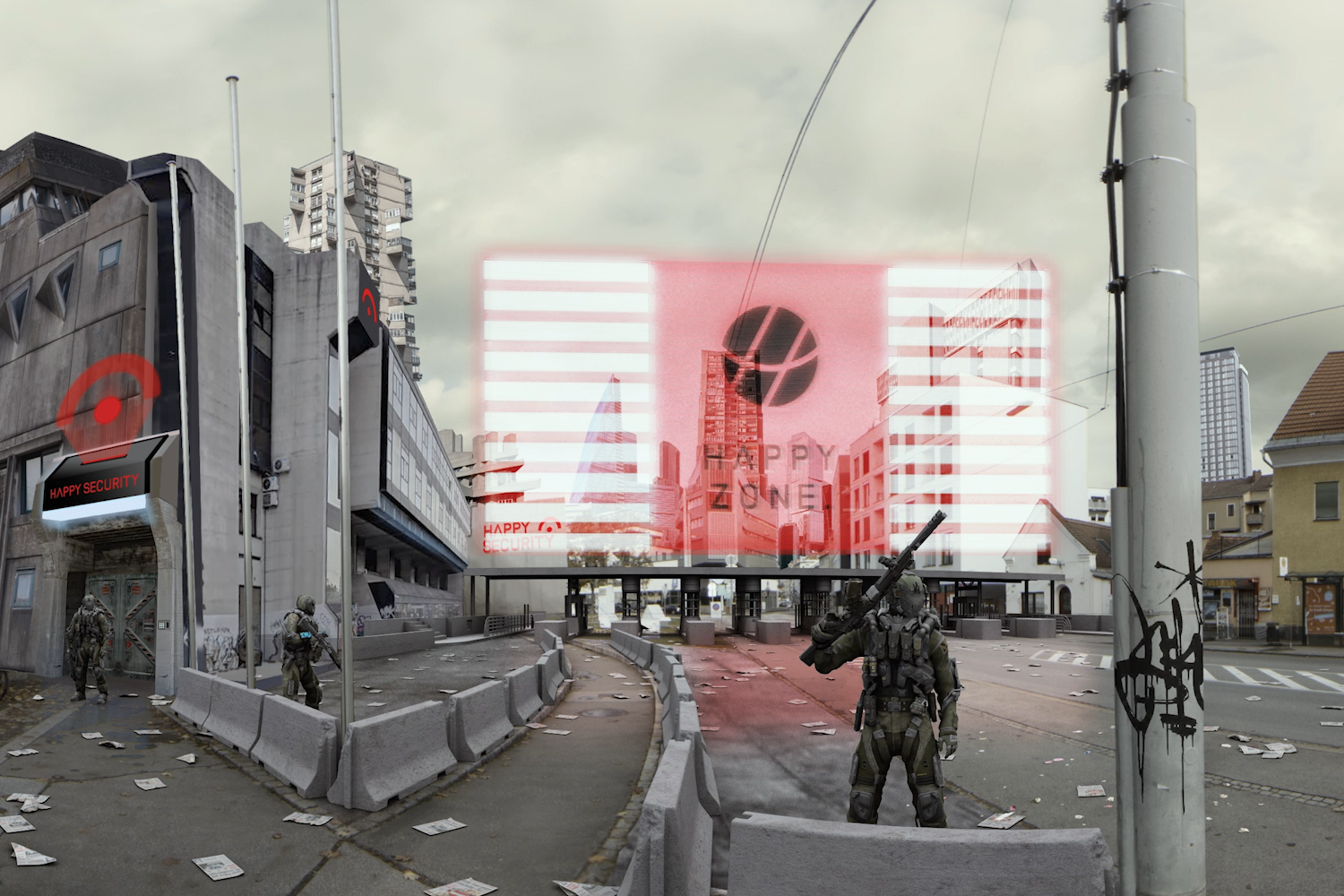
Prism Break
The year 2069 - New developments in quantum-computing pushed the processor requirements to a minimum, which in turn stepped up the capabilities of the - to that point somewhat sluggish - handhelds to unprecedented levels and speeds.
First and foremost this processing power was used for instant face recognition softwares, which allowed high-strata-consumers to scan their social environment for total transparency. This technology was primarily championed by the ever bigger 'Happy-Corporation'.
Their gigantic data-base allowed full and in-depth instant background checks and information (insta-scan), which – to most clients - was paramount in a general climate of insecurity and stealth dangers.
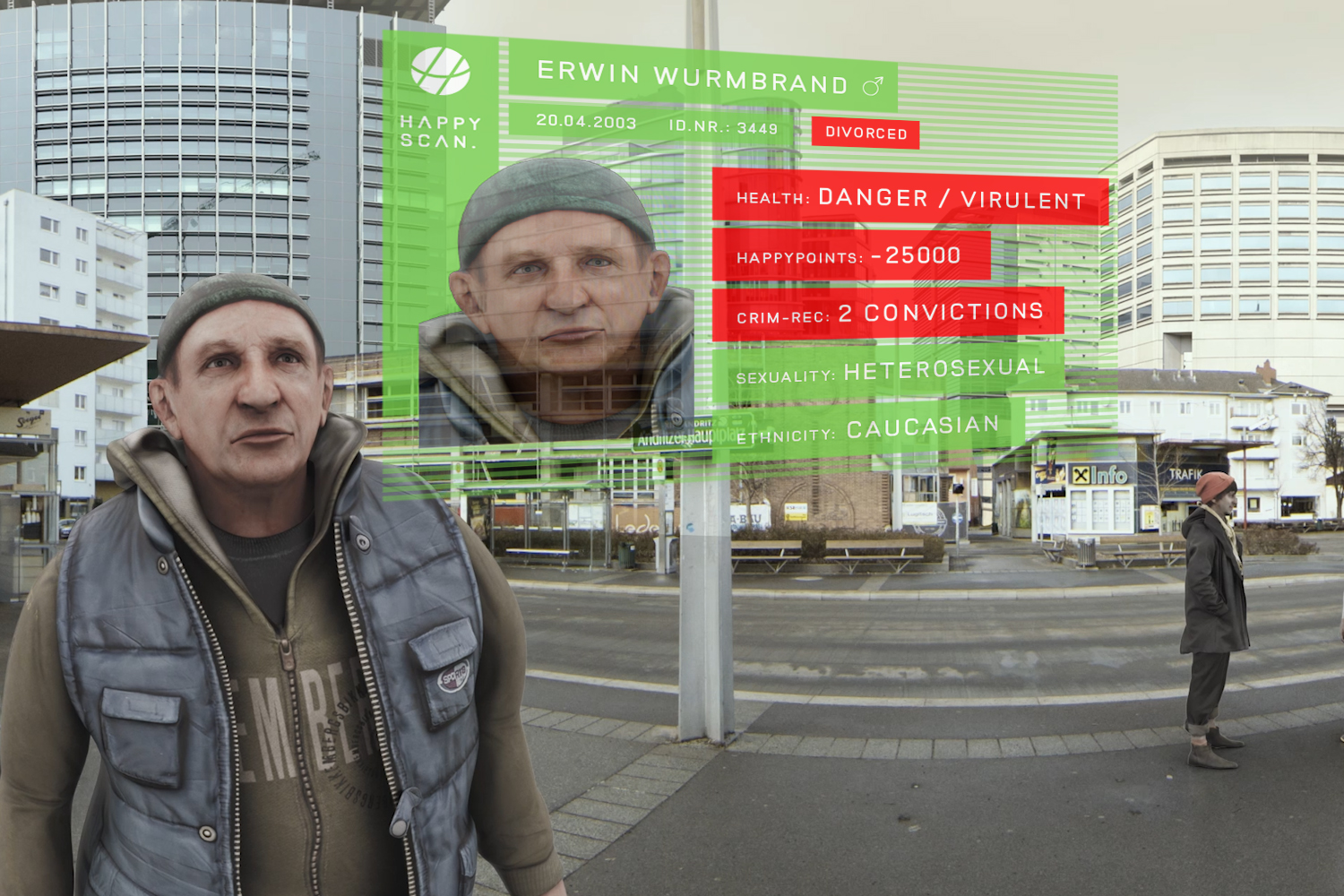
Quantum Reaper
The Year 2072 - Quantum Computing technology was now readily available and implemented in almost every field. It provided a gigantic leap forward for Artificial Intelligence. AI could now be used for a wide variety of tasks, including traditional hand-crafts like building and architecture.
The concept of 'aesthetics' had been abandoned completely under the aegis of 'FAST-HAUS' school in the early 2050s which freed up building speed and intensity. The paramount priority for architecture was quantity. These paradigms provided the perfect setting for AI in urban developments, both in planning and construction. Occasional 'glitches' – structural or static miscalculations / unstable structures - were regarded as a necessary learning curve for the so called 'Arch-Bots'.
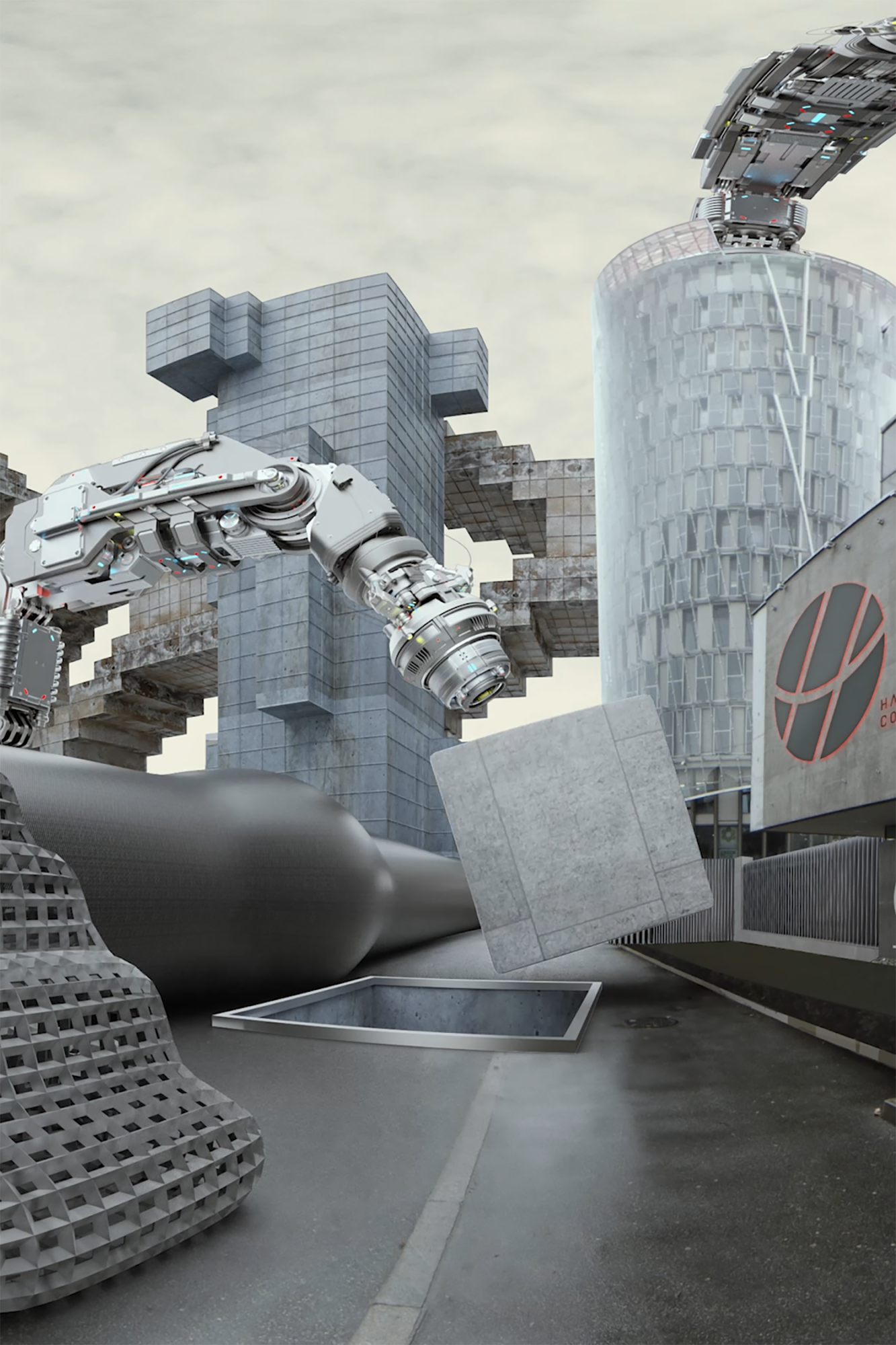
Entitlementality
The Year 2075 - Airpollution had been one of the major problems since the beginning of industrialisation in urban settings. Manyfold attempts were made to tackle this issue since the late 90s of the previous century, yet no real solution had been able to counteract the ever growing levels of emissions.
Rising temperatures also meant that more median energy was stored in the atmosphere. This, in turn, acted as an agent for higher levels of micro-particles to be suspended in the 'air'. However, one way of using this pollution to a consumer's advantage was to project messages into the sky via 'reflecturing'. In short, an image was being projected onto the sky which used certain layers of micro-particles as aerosol-canvas.

Dencity
The year 2084 - Even though the demand for single-family housings was still high the constraining factors of space and energy-efficiency shifted the prerogatives of urban structures to high-density blocks. These high-rise buildings usually were divided equally into living and working/office areas. This had the additional effect of keeping commuting times to a minimum as clients were able to rent these micro apartments at a reduced price in case it was located in the same structure.
The Happy-Corporation was able to enforce a monopoly for contracting the building in the mid 2080s due to their advanced position in AI-building and Arch-Bots.
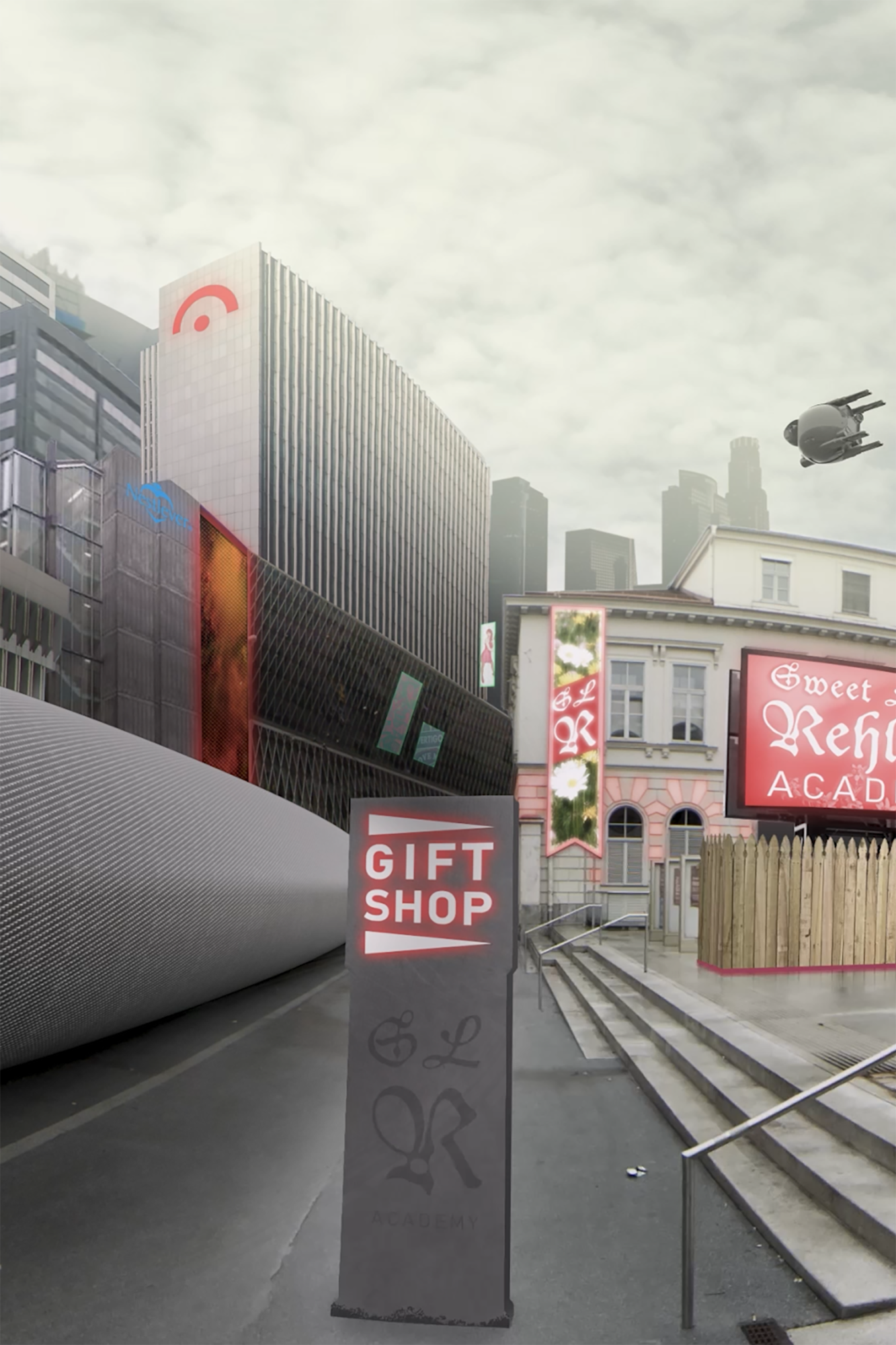
Anarchitecture
The Year 2099 - One way of protecting clients of older urban dwellings against the increasing air pollution and heat was to create giant encasings for lower built structures. This however was seen as a makeshift-measure as these 'spaces' conveyed an air of sovereignty, sometimes even 'autarchy'. In most cases the 'hangars' were used by mid-strata-consumers, sometimes even low-strata-consumers as they were generally situated outside the happy-zones. In turn these 'hangars' were developing into a quasi-outlaw areas.
Abysmal maintenance and repairs due to failing happy-points-situations turned these areas into more and more derelict zones, which had to be frequently raided by Happy-Security in order to keep a minimum level of law and order.

Happy Trigger Happy
The Year 2101 - Frictions arose frequently on the borders of the happy-zones as low-strata and expels ventured unlawfully into other areas without providing the required happy-point-status. As these intruders were seen as threat to safety happy-security-agents were given extensive liberties in executing and enforcing law and status-calm. In severe cases agents could incapacitate intruders terminally, i.e execute those who could not provide a valid happy-number on their happy-scan.

Deserter
The Year 2109 - Temperatures had been rising continuously while precipitation was accumulated in short but intense timeframes. The quantities of water were dramatically too high to absorb for the small areas of natural soil that had been left unsealed.
Median wind-speeds were increasing equally due to higher pressure gradient differences.
These two factors primarily contributed to the erosion and subsequent desertification of vast areas in Northern Europe. Attempts were made to stabilize the soil with flora more fit to sustain long periods of drought and hotter climates, but few of these succeeded in the long term. As a natural consequence a new fauna entered areas that had previously been domains for boreal and subtropical animals.
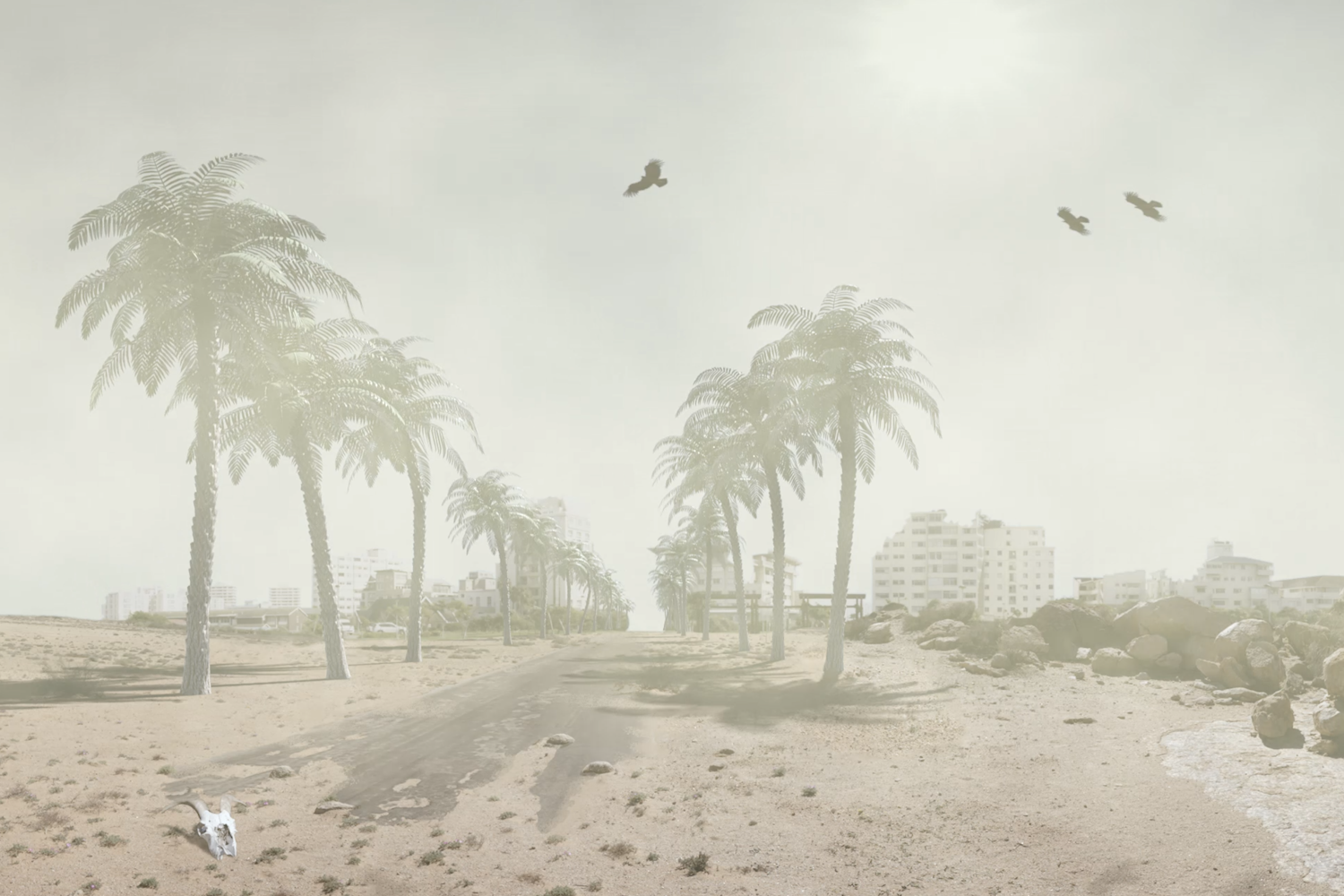
The Dome
The Year 2115 - The idea of creating superstructures that would provide sealed micro-climates in order to facilitate a more agreeable habitat for humans had been floating around since decades but technological difficulties defied the construction of these enormous required spans. However, in the year 2111 the newly built humanoid AI computer built by Happy-RD created a crystallomorphic macro-molecule that enabled construction of virtually endless spans. With this 'invention' the 'climate dome' was finally made possible. Construction began in 2113. It was finished just two years later.

Holobeauty
The Year 2120 - The construction of the climate domes consumed vast amounts of monies and left fiscal situations in disarray. Almost all strata could experience the effects of the newly instated austerity measures.
The most obvious effects however were seen in the maintenance and repair of mid-strata and low-strata areas. Whole precincts were literally falling to pieces without any effort being made to reconstruct or repair. The cheapest solution, once again provided by Happy-RD, was to create holograms that would cover the derelict facades with cheerful and calming scenes. The production of content was mainly left to AI due to the lack of creative personnel.
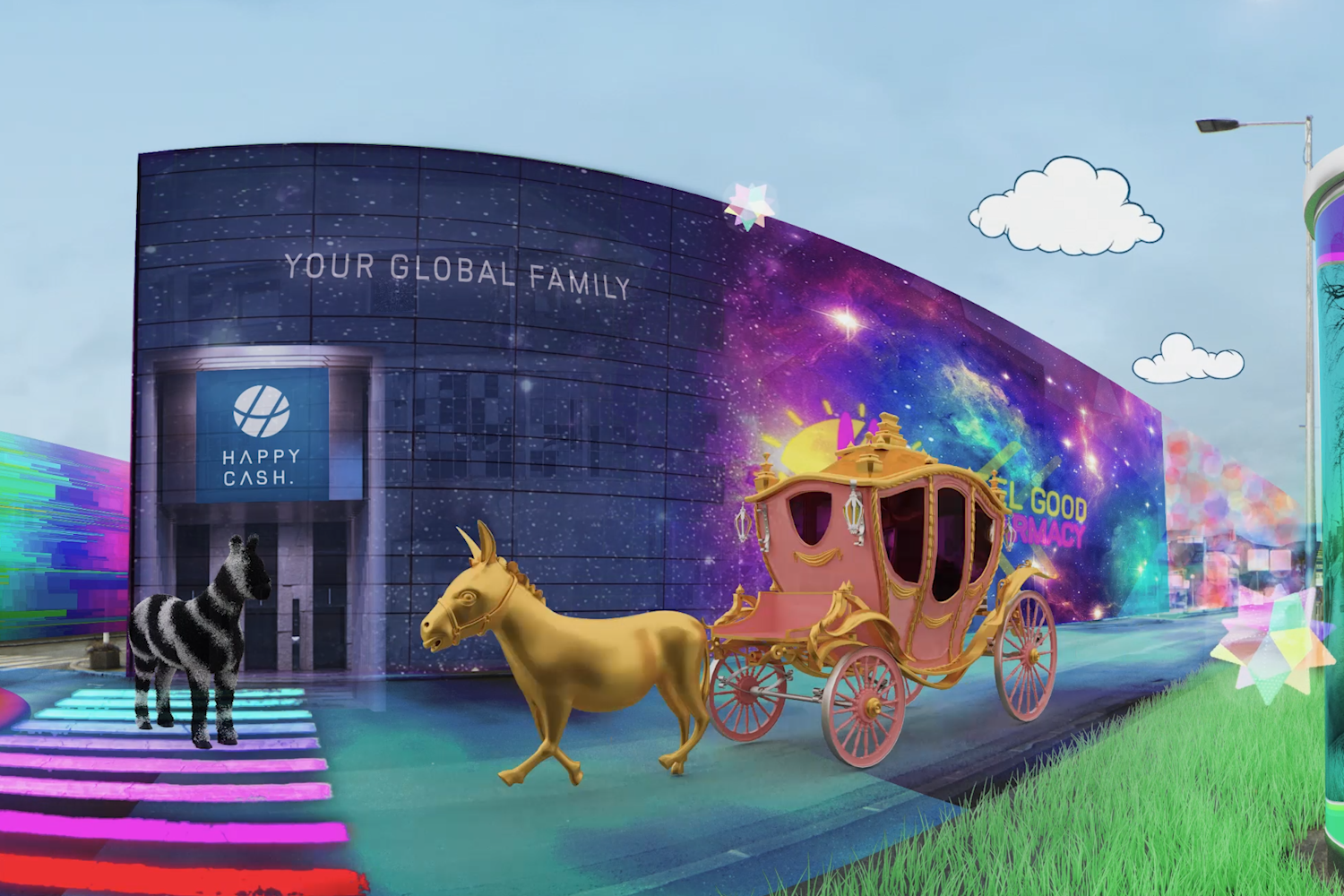
DYSTOPTIMAL
-
Animates citizens and visitors to experience Graz
- Austria’s second biggest city - from a new perspective.
How
The user will be immersed in a dystopian 3D environment via a smartphone or tablet which maps a possible future over the actual, current urban topography. The scenes are animated and locked to specific geolocated markers in order to align with and and imitate any movement the user wishes to make. Additionally a specific sound-design will be created that will deepen the immersive character of the 'mini-movies'. Once the user dis-engages the app or simply puts down his smart-phone he or she should experience the city and its qualities, its esthetics and 'natural' environments from a new, refreshed and holistic point of view. Furthermore the city can be explored in a joyful and 'game-app' kind of way by guiding users to unknown or less frequented places.
